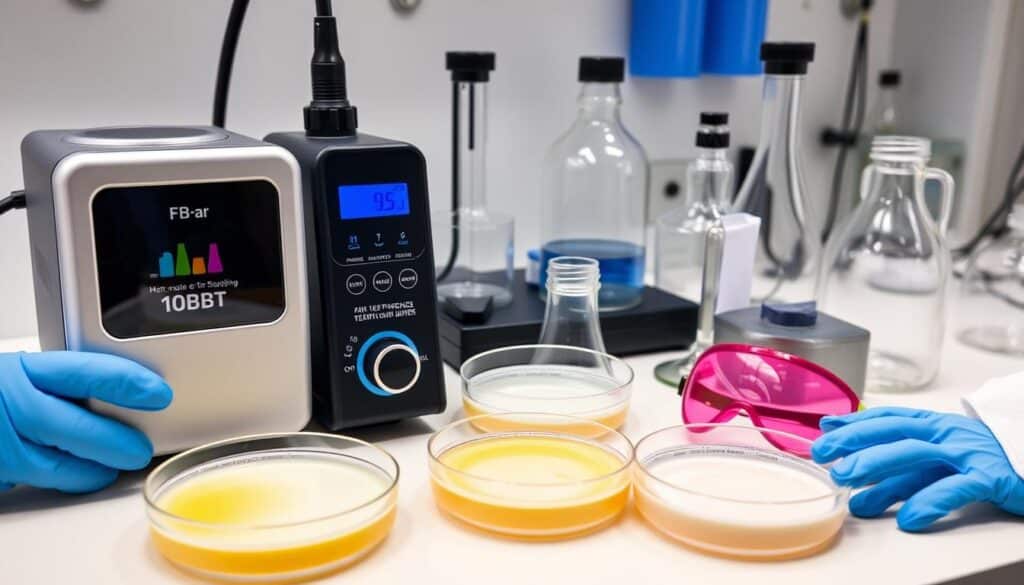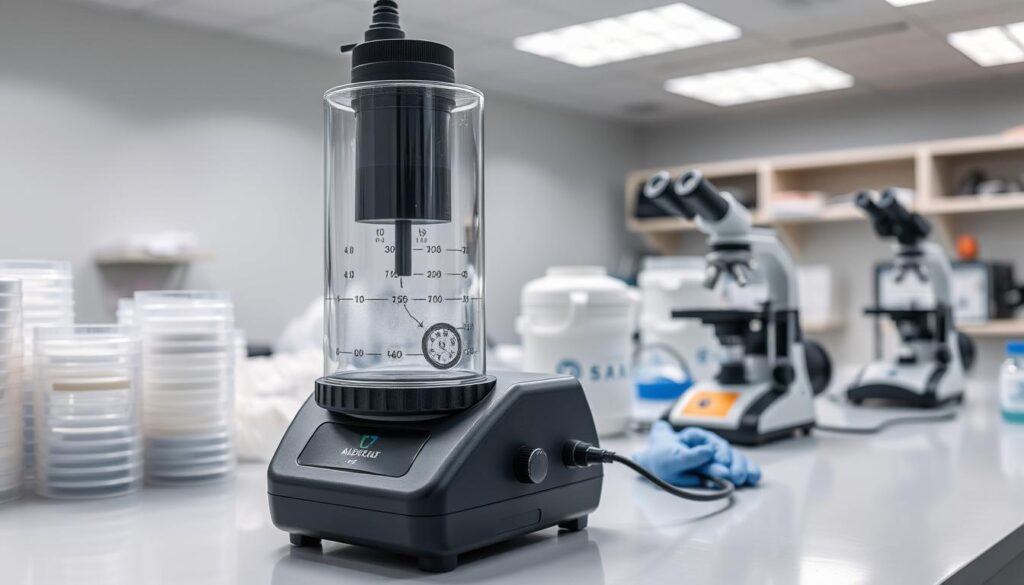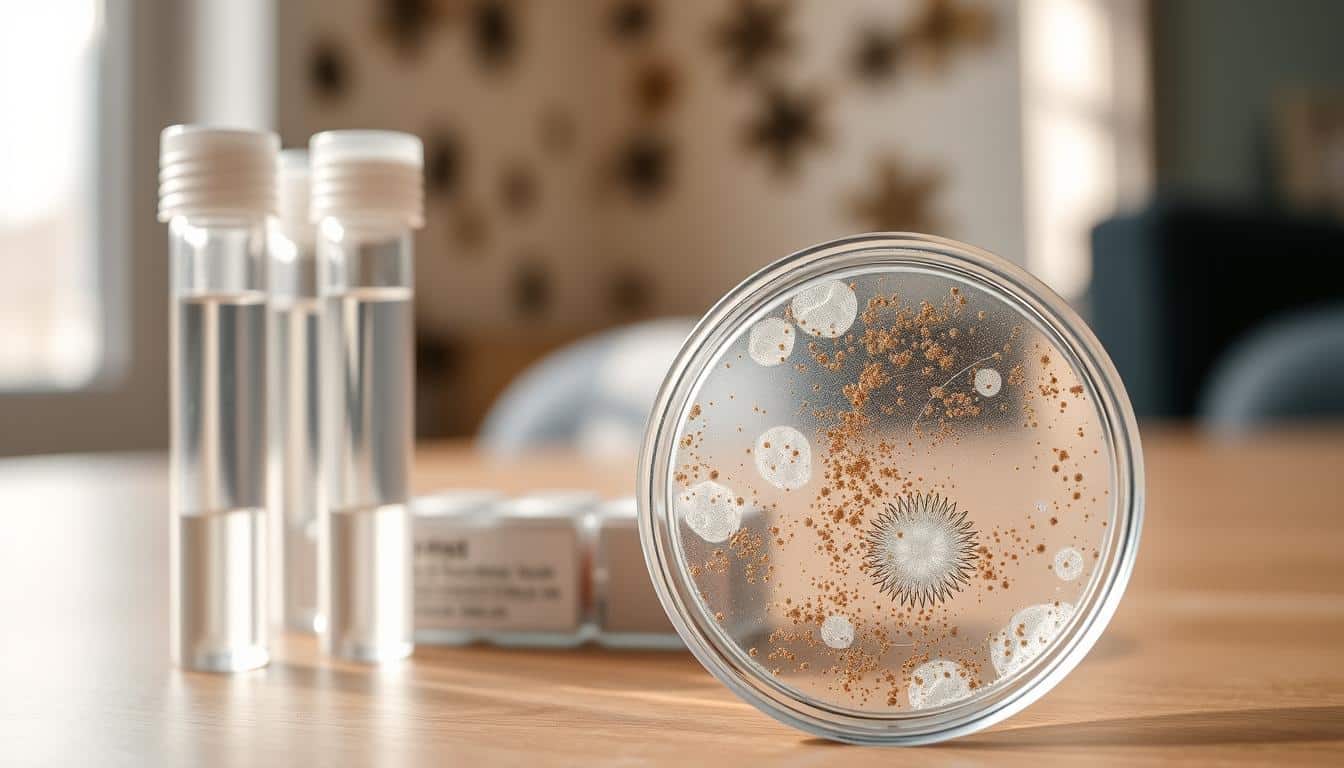Did you know that 48% of homes in the United States have visible evidence of dampness or mold? This is a shocking fact that shows how important indoor air quality testing is. As a homeowner, I’ve found that an air sample mold test is essential for a healthy home.
Mold spores are too small to see with our eyes, but they can harm our health. That’s why it’s vital to have regular mold inspections. With the right tools, we can catch these tiny particles and figure out what kind of mold is in our homes.
I’ve learned that air sampling is a big part of professional mold inspections. It’s amazing how these tests can find mold problems that we can’t see. By using special devices, inspectors can collect samples that tell us a lot about our indoor air.
Key Takeaways
- Air sample mold tests detect invisible spores in indoor environments
- Professional mold inspections often include air sampling techniques
- These tests help identify hidden mold issues and assess exposure risks
- Air sampling can determine the types and concentrations of mold present
- Regular indoor air quality testing is crucial for maintaining a healthy home
Understanding the Importance of Mold Testing
Mold testing is key to keeping our homes healthy. Mold spores are everywhere, but they can be a big problem indoors. Let’s see why testing for mold is so important and how it keeps us safe and our homes in good shape.
Health Risks Associated with Mold Exposure
Mold can cause serious health problems. It can lead to breathing issues, allergies, and make asthma worse. People with weak immune systems are at even greater risk. Testing for mold regularly can spot health dangers early.
Potential Damage to Property
Mold can destroy your home. It can damage materials, stain walls, and even harm the structure. Finding mold early can save you a lot of money on repairs. It helps keep your home safe and its value high.
Early Detection Benefits
Testing for mold early has many benefits. It lets us fix problems quickly, stopping them from getting worse. This helps protect our health and property. It also saves money by fixing issues before they get out of hand.
| Benefit | Impact |
|---|---|
| Health Protection | Reduces risk of respiratory issues and allergies |
| Property Preservation | Prevents structural damage and maintains home value |
| Cost Savings | Avoids expensive repairs and remediation |
| Peace of Mind | Ensures a safe and healthy living environment |
It’s crucial to test for mold often, especially in damp areas or after water damage. By being proactive and testing for mold regularly, we can make our homes safer and healthier for everyone.
What is an Air Sample Mold Test?
An air sample mold test is key in checking for mold in the air. It helps find mold spores floating around indoors. To do this, I use special tools to catch these tiny particles.

I often use impaction samplers, cassette samplers, or airborne-particle collectors. These tools pull in air and catch mold spores on a sticky surface or in liquid. Then, the samples go to a lab for testing.
In the lab, experts figure out what kind of mold is there and how much. This info is crucial for knowing if the air inside is safe. Air sampling is great because it finds mold that you can’t see, giving a full view of mold in a space.
- Detects airborne mold spores
- Uses specialized sampling equipment
- Provides comprehensive mold assessment
- Identifies hidden mold problems
The American Society for Testing and Materials (ASTM) has rules for mold tests. These rules make sure tests are done right and reliable.
Air sample mold tests are part of a detailed mold check. They work best with visual checks and surface tests. This way, we get a full picture of mold and health risks in a building.
When to Conduct an Air Sample Mold Test
Many people wonder when it’s the right time for a mold inspection. The answer is simple: several situations call for an air sample mold test. Let’s look at when you might need this important step for your home’s health.
Signs of Visible Mold Growth
If you see any discoloration or fuzzy growth on walls, ceilings, or surfaces, it’s time for a test. Indoor air quality testing can show how big the problem is, even if you can’t see mold everywhere.
Musty Odors in Your Home
A musty smell that won’t go away is a warning sign. It usually means there’s mold hiding somewhere. An air sample test can find mold spores and help find where the smell is coming from.
After Water Damage or Flooding
Water damage or flooding creates a perfect environment for mold. I always suggest a mold inspection after such events. It’s important to act quickly to stop mold from spreading.
| Scenario | Test Recommendation | Typical Air Sample Volume |
|---|---|---|
| Visible Mold | Immediate Testing | 75 liters |
| Musty Odors | Prompt Assessment | 75 liters |
| Post-Water Damage | 24-48 Hour Window | 75 liters |
Remember, regular testing is important in homes with high humidity or a history of mold. By doing air sample mold tests on time, you’re taking a big step towards a healthier home.
Air Sample Mold Test: Equipment and Methodology
Air sample mold tests are key for spotting indoor spores. They use special tools and methods for accurate results. Let’s explore how mold sampling and air monitoring work.

The main tools for air sample mold tests are impaction samplers, cassette samplers, and airborne-particle collectors. These gadgets use a calibrated air pump. It pushes air through a collection mechanism, catching mold spores for study.
Here’s how I do mold sampling:
- Place the sampler 3 to 6 feet off the ground, near the room’s center
- Run the air pump for about 10 minutes, adjusting based on environmental factors
- Collect samples in a closed environment to minimize external influences
- Send collected samples to a laboratory for professional analysis
Air monitoring is key to find out the types and amounts of mold spores in your home. Lab analysis usually costs about $39 per sample. It gives important info about your indoor air quality.
| Testing Method | Duration | Incubation Period |
|---|---|---|
| Indoor Air Quality Test | 1 hour exposure | 48 hours |
| HVAC Air Sampling | 10 minutes | 48 hours |
| Surface Sampling | Immediate swab | 48 hours |
If you want to test your home’s air yourself, air quality test kits are available for about $29.99. These kits are a budget-friendly way to check your home’s air. But, professional tests give more detailed results.
Ideal Conditions for Air Sampling
When we do a mold assessment or test the air quality, it’s key to set up the right setting. I’ve learned that the right conditions help us get accurate results. This way, we can find and fix any problems more easily.
Closed Environment Requirements
For top results, I suggest keeping windows and outside doors closed during the test. This keeps the air steady, showing us what’s really in your indoor space. It’s also crucial to turn off air exchangers and fans to reduce air movement.
Weather Considerations
Weather can really affect our mold tests. Big storms or strong winds can mess up the data. So, I aim to test on a calm, dry day.
Optimal Sampling Duration
The best time for air sampling is usually 10 minutes. This time lets us gather enough data for a detailed analysis. In busy or dusty areas, I might cut the time to 5 minutes to avoid too much data.
| Sampling Condition | Recommendation |
|---|---|
| Environment | Closed, with HVAC systems off |
| Weather | Calm, dry conditions |
| Duration | 10 minutes (5 minutes for high-activity areas) |
| Frequency | Every 6 months (more often for high-risk areas) |
For the most precise mold assessment, we should test under normal conditions in living areas. This method gives us the clearest view of your daily indoor air quality.
Interpreting Air Sample Mold Test Results
Understanding air sample mold test results is key for effective mold analysis. These tests compare indoor and outdoor mold spore levels and types. If indoor levels are higher or different types are found indoors, it could mean a mold issue.
Results from an air sample mold test show mold types and their counts in spores per cubic meter of air. It’s often needed to have a pro interpret these results. They help figure out if more action is required.
Here’s a breakdown of common mold species found in air samples:
- Ascospores: Found everywhere in nature
- Penicillium/Aspergillus: Common in indoor and outdoor air, mostly allergenic
- Basidiospores: Typically outdoor, from gardens and forests
- Cladosporium: Grows indoors, spores present in both environments
- Stachybotrys: Considered hazardous and requires removal
Mold spore levels can vary a lot. A total spore count over 1,000 spores/M3 might show a problem. Penicillium/Aspergillus levels above 600 spores/M3 or Chaetomium above 300 spores/M3 are also important.
There are no federal or state limits for airborne indoor mold. That’s why getting a pro to interpret air sample mold test results is crucial. They help guide how to fix the mold and check if it’s working.
DIY vs. Professional Mold Testing
Homeowners have to choose between DIY kits and professional services for mold inspection. I’ve looked into both to guide you on indoor air quality testing.
Advantages of DIY Kits
DIY mold test kits are affordable, costing $50 to $100 per room. You can find them online or in hardware stores. They come with tools and instructions for sending samples to a lab.
Benefits of Professional Testing
Professional mold testing gives detailed results. Experts use special equipment and send samples to accredited labs. They can find different mold types and compare indoor air to outdoor levels. This helps create a good plan to fix mold problems.
Cost Comparison
DIY kits are cheaper at first, but professional services are more valuable. Here’s a comparison:
| Aspect | DIY Kits | Professional Testing |
|---|---|---|
| Cost | $50-$100 per room | $200-$800 per service |
| Accuracy | Limited | High |
| Expertise | None | Certified professionals |
| Comprehensiveness | Basic | Detailed analysis |
| Action Plan | Not provided | Included |
If you have serious mold issues or after water damage, get a professional mold inspection. It ensures your indoor air is safe. DIY kits are good for a first check, but experts catch more.
Common Types of Mold Detected in Air Samples
In my work with mold analysis, I’ve found many types of mold in air samples. The most common ones are Aspergillus, Penicillium, and Cladosporium. These fungi can cause allergies and make asthma worse.
Here’s what we usually find in air samples:
| Mold Type | Normal Level (spores/m³) | Concerning Level (spores/m³) |
|---|---|---|
| Aspergillus/Penicillium | 0-700 | 1500+ |
| Cladosporium | 0-500 | 1000+ |
| Stachybotrys (Black Mold) | 0-50 | 200+ |
Stachybotrys, or black mold, is less common but very toxic. It grows in damp areas. I also watch for Chaetomium and Memnoniella, which show long-term moisture problems and are as dangerous as Stachybotrys.
Spore levels between 500-1500 per cubic meter can be normal in some cases. But, if I see levels over 3000 spores/m³, I suggest fixing the problem right away. Almost 80% of houses bought for flipping need mold removal, showing how important testing is.
Don’t rely on just looking at a room. I’ve seen rooms that seemed clean but had high spore counts. That’s why getting a professional to test the air is crucial for a healthy home.
Steps to Take After a Positive Mold Test
When I get a positive mold test, I act fast. First, I find the source of moisture. This could be a leak, bad ventilation, or water damage. Fixing these is key to stop mold from coming back.
For big mold problems, I call in the pros for mold remediation. They have the right tools and know-how to safely remove mold. They also clean and disinfect well.
After fixing the mold, I focus on preventing it. I use dehumidifiers or improve ventilation to keep humidity right. Regular indoor air quality tests help catch problems early.
“Mold can begin to grow into a colony within 24-48 hours of a mold spore landing on a wet surface.”
Here’s what I do after a mold test:
- Find and fix moisture sources
- Call in mold remediation pros
- Clean and disinfect affected areas
- Throw out materials too damaged
- Take steps to prevent mold
- Do a follow-up test to check if it worked
| Step | Time Frame | Importance |
|---|---|---|
| Fixing moisture source | Immediate | Critical |
| Professional remediation | Within 48 hours | High |
| Follow-up testing | 2-4 weeks post-remediation | Essential |
Quick action is crucial. Mold can spread fast, causing health problems and damage. By taking these steps, I keep my home safe and mold-free.
Conclusion
I’ve explored air sample mold tests and indoor air quality testing. These tools are key for a healthy home. With mold in about 70% of U.S. homes, regular checks are vital.
Air sampling is a main way to find mold. It shows what types and how many spores there are. If there are more than 500 spores per cubic meter, it’s a sign of a problem. Some molds, like Stachybotrys, can be harmful.
While DIY kits exist, professional testing gives better results. Experts can understand the data and suggest the best actions. They consider many factors, like the ratio of indoor to outdoor spores.
Being careful and quick to deal with mold helps keep us and our homes safe. Regular tests are a wise choice for our health. Let’s focus on clean air and safer homes for everyone.
FAQ
What are the health risks associated with mold exposure?
Mold can cause breathing problems and allergic reactions. It can also trigger asthma attacks. People with weak immune systems or breathing issues are at higher risk.
How can mold growth damage properties?
Mold can damage materials in homes and buildings. It can weaken structures and contaminate surfaces. Finding and fixing mold early can save money and health.
What is an air sample mold test, and how does it work?
An air sample mold test collects air using special tools. These tools capture mold spores in the air. Then, a lab analyzes the samples to find out what mold is present.
When should I conduct an air sample mold test?
Test for mold when you see it, smell musty odors, or after water damage. Testing regularly is also good, especially in damp places or for those sensitive to mold.
What equipment and methods are used for air sample mold testing?
Tools like impaction samplers and cassette samplers are used. They force air through a device to catch mold spores. This is done to analyze the air for mold.
What are the ideal conditions for air sampling?
The best time to sample air is in a closed space. Make sure windows and doors are shut, and there are no fans. Sampling usually takes about 10 minutes, but can vary.
How are air sample mold test results interpreted?
Results are compared to outdoor mold levels. If indoor levels are higher or different, it might mean mold is present. Experts usually interpret these results.
What are the advantages of DIY mold testing kits versus professional testing?
DIY kits are cheaper for a quick check. But, professional tests give detailed results and expert advice. DIY kits cost about , while professional tests can be 0 to 0.
What are some common types of mold detected in air samples?
Common molds found include Aspergillus, Penicillium, and Cladosporium. Stachybotrys (black mold), Alternaria, and Fusarium are also common. Finding these can show health risks and the need for cleaning.
What steps should be taken after a positive mold test?
First, find and fix the moisture problem. Then, clean and disinfect the area. Throw away materials that are too contaminated. Use dehumidifiers or better ventilation. Test again after cleaning to make sure the mold is gone.




